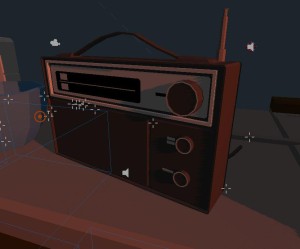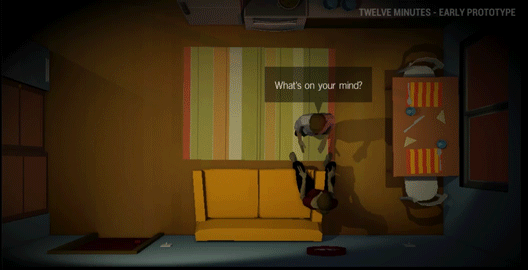If Twelve Minutes was an illustration, I would say I’ve just finished the sketch (prototype) and I’m now starting the inking stage, cleaning up the drawing to later add color and shades (production).
In this post I’ll cover what I’ve been doing over the past month; reviewing the main puzzles and storyline to make sure they flow well, adding extra layers to character behavior and figuring out any missing requirements for production.
Everything is connected in some way in the game. The layout of the apartment, the placement of objects, the distances between rooms, sight lines and timing of events. It should all feel natural but the more you play, the more you realize the patterns and opportunities that you can use to your advantage.

There are few objects in the apartment and each one has more than one purpose. The complexity of combinations is fairly high and any small design change can end up breaking something somewhere else that I had forgotten about, kinda like a butterfly effect.
Throughout the last year this happened several times and I’ve learned to write down the major puzzles and reasoning for certain things. Since these have barely changed for some time now I can start adding a new layer of complexity to the actors behavior.
I’ve focused mostly on the wife, making sure she reacts to small unnatural things the player might try, like leaving the front door open and going to another room, or hiding in a corner of the apartment and just staying there without moving.
These reactions allow the player to fell the dynamic between the couple, to better read the wife’s personality and make her more believable and relatable overall.

And this makes you care more about her, which leads to another addition, being able to ask how she is feeling.
It doesn’t exactly change her behavior (unless you keep asking it over and over) but it allows you a better understanding of what is on her mind. It also prevents the issue of a player trying to engage in a dialog and if there are no more available options to get a “I have nothing to talk about right now”.
Another aspect I’ve been working is audio emotions.
For some time I had planned to have recorded audio for the dialogs but realized that hearing each actor say the same lines over and over would become annoying fast, not to mention the extra amount of work if I want to do any last minute changes or for localization.
But most importantly, in the same way you don’t get a close up on a character’s face when they speak (like most point and click games do), the lack of spoken dialog allows the player to fill in the blanks in how a certain line is being said. Maybe you feel the character is more angry or more calm or maybe being ironic. And this adds to the immersion, besides preventing all the uncanny valley issues.
The audio emotions are sounds that play when the actors speak or do an action (e.g. surprised, crying or scared). For gameplay reasons I needed to add some and I really like how they fit with the aesthetic of the game. I’ve been adding more subtle ones during dialogs, like small giggles or a sign of relief or tiredness.
The last aspect I tried to figure out was the timing of actions. At the moment, most of them are instantaneous. (e.g. grabbing an object from a surface, filling a glass with water, etc).
Since the game is in real time and the loops are already very short, I wanted to be sure that adding more seconds to each action would not affect the overall timing.
So far so good, the new timings are small enough not to break the gameplay flow, but long enough to ground what the actors are doing. I’m also starting to realize that I will probably need to estimate a few more work hours when I hire an animator later on.
I still need to figure out the nightmare of opening and closing doors while other actors are going through them but I’ll leave that to another post!